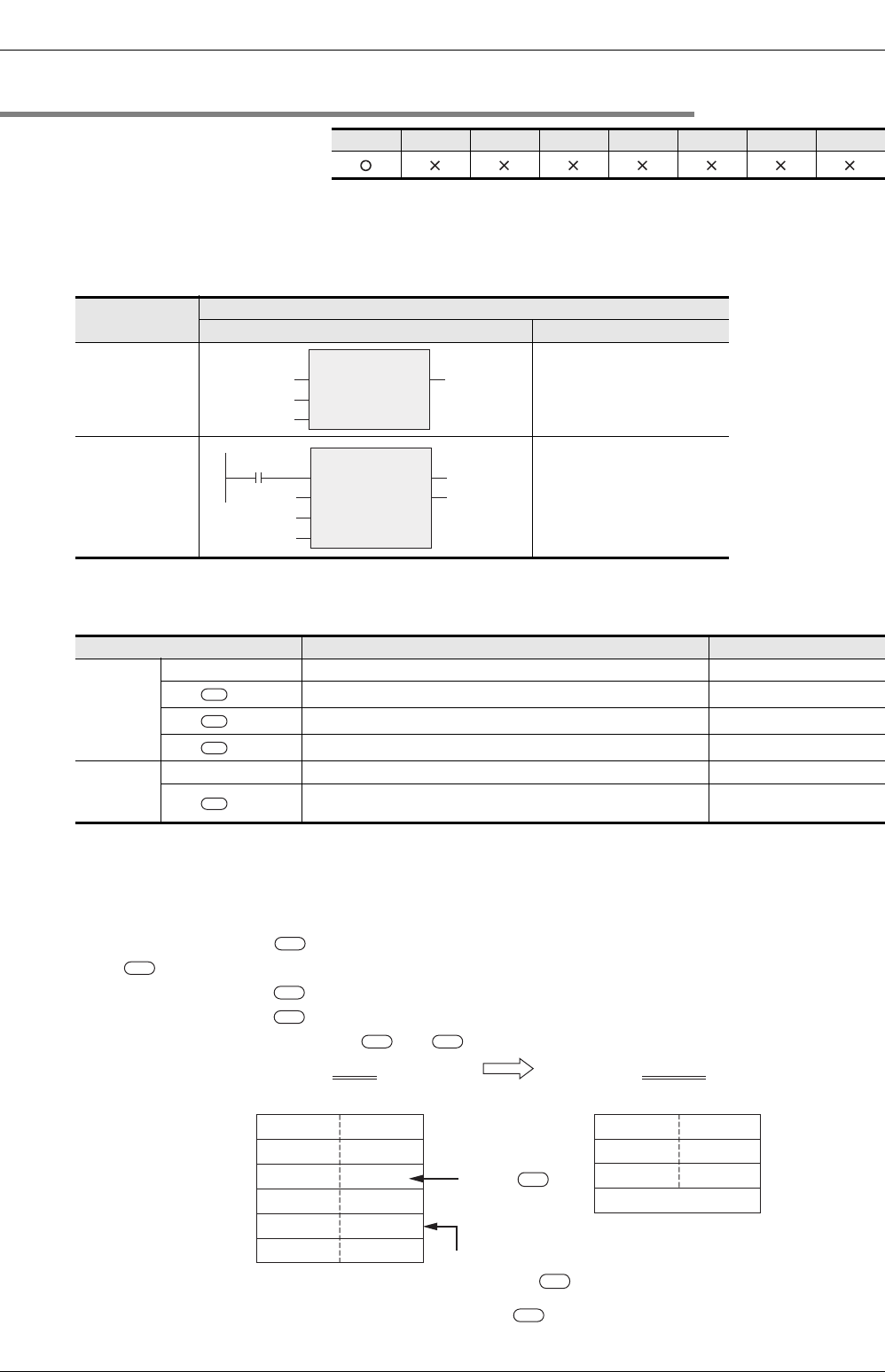User's Manual
Table Of Contents
- Front Cover
- Manual number
- Table of Contents
- Positioning of This Manual
- Related Manuals
- Generic Names and Abbreviations Used in Manuals
- 1. Outline
- 2. Function List
- 2.1 Type Conversion Functions
- 2.2 Standard Functions Of One Numeric Variable
- 2.3 Standard Arithmetic Functions
- 2.4 Standard Bit Shift Functions
- 2.5 Standard Bitwise Boolean Functions
- 2.6 Standard Selection Functions
- 2.7 Standard Comparison Functions
- 2.8 Standard Character String Functions
- 2.9 Functions Of Time Data Types
- 2.10 Standard Function Blocks
- 3. Function Construction
- 4. How to Read Explanation of Functions
- 5. Applied Functions
- 5.1 Type Conversion Functions
- 5.1.1 BOOL_TO_INT(_E)
- 5.1.2 BOOL_TO_DINT(_E)
- 5.1.3 BOOL_TO_STR(_E)
- 5.1.4 BOOL_TO_WORD(_E)
- 5.1.5 BOOL_TO_DWORD(_E)
- 5.1.6 BOOL_TO_TIME(_E)
- 5.1.7 INT_TO_DINT(_E)
- 5.1.8 DINT_TO_INT(_E)
- 5.1.9 INT_TO_BOOL(_E)
- 5.1.10 DINT_TO_BOOL(_E)
- 5.1.11 INT_TO_REAL(_E)
- 5.1.12 DINT_TO_REAL(_E)
- 5.1.13 INT_TO_STR(_E)
- 5.1.14 DINT_TO_STR(_E)
- 5.1.15 INT_TO_WORD(_E)
- 5.1.16 DINT_TO_WORD(_E)
- 5.1.17 INT_TO_DWORD(_E)
- 5.1.18 DINT_TO_DWORD(_E)
- 5.1.19 INT_TO_BCD(_E)
- 5.1.20 DINT_TO_BCD(_E)
- 5.1.21 INT_TO_TIME(_E)
- 5.1.22 DINT_TO_TIME(_E)
- 5.1.23 REAL_TO_INT(_E)
- 5.1.24 REAL_TO_DINT(_E)
- 5.1.25 REAL_TO_STR(_E)
- 5.1.26 WORD_TO_BOOL(_E)
- 5.1.27 DWORD_TO_BOOL(_E)
- 5.1.28 WORD_TO_INT(_E)
- 5.1.29 WORD_TO_DINT(_E)
- 5.1.30 DWORD_TO_INT(_E)
- 5.1.31 DWORD_TO_DINT(_E)
- 5.1.32 WORD_TO_DWORD(_E)
- 5.1.33 DWORD_TO_WORD(_E)
- 5.1.34 WORD_TO_TIME(_E)
- 5.1.35 DWORD_TO_TIME(_E)
- 5.1.36 STR_TO_BOOL(_E)
- 5.1.37 STR_TO_INT(_E)
- 5.1.38 STR_TO_DINT(_E)
- 5.1.39 STR_TO_REAL(_E)
- 5.1.40 STR_TO_TIME(_E)
- 5.1.41 BCD_TO_INT(_E)
- 5.1.42 BCD_TO_DINT(_E)
- 5.1.43 TIME_TO_BOOL(_E)
- 5.1.44 TIME_TO_INT(_E)
- 5.1.45 TIME_TO_DINT(_E)
- 5.1.46 TIME_TO_STR(_E)
- 5.1.47 TIME_TO_WORD(_E)
- 5.1.48 TIME_TO_DWORD(_E)
- 5.2 Standard Functions Of One Numeric Variable
- 5.3 Standard Arithmetic Functions
- 5.4 Standard Bit Shift Functions
- 5.5 Standard Bitwise Boolean Functions
- 5.6 Standard Selection Functions
- 5.7 Standard Comparison Functions
- 5.8 Standard Character String Functions
- 5.9 Functions Of Time Data Types
- 5.1 Type Conversion Functions
- 6. Standard Function Blocks
- Appendix A: Correspondence between Devices and Addresses
- Warranty
- Revision History
- Back Cover

5.8 Standard Character String Functions
190
FXCPU Structured Programming Manual
(Application Functions)
5.8.4 DELETE(_E)
Outline
This function deletes a character string.
1. Format
*1. Output variable
2. Set data
In explanation of functions, I/O variables inside ( ) are described.
Explanation of function and operation
1) This function deletes specified number of characters from an arbitrary position of a character string stored
in devices specified in , and outputs the character string remaining after deletion to devices specified
in .
The value specified in specifies the number of characters to be deleted.
The value specified in specifies the position from which specified number of characters are deleted.
Example: When "5" is specified in and
2) A character string (data) stored in devices specified in indicates the data until "00H" is detected first
in units of byte in the range starting from the specified device.
FX3U(C) FX3G FX2N(C) FX1N(C) FX1S
FX
U
/FX
2C
FX0N FX0(S)
Function name
Expression in each language
Structured ladder ST
DELETE
DELETE(_IN,_L ,_P);
Example:
Label 2:=
DELETE(Label 1,D10,D20);
DELETE_E
DELETE_E(EN,_IN,_L ,_P,
Output label);
Example:
DELETE_E(X000, Label 1,
D10, D20, Label 2);
Variable Description Data type
Input
variable
EN Execution condition Bit
_IN ( )
Head word device which stores a character string to get deletion String
_L ( )
Number of characters to be deleted Word [signed]
_P ( )
Head position to get deletion Word [signed]
Output
variable
ENO Execution status Bit
*1 ( )
Head word device which will store a character string remaining after
deletion
String
DELETE
*1
Label 2Label 1 _IN
_L
D10
_P
D20
DELETE_E
EN ENO
*1
Label 2
X000
Label 1
_IN
_L
D10
_P
D20
s
n1
n2
d
s
d
n1
n2
n1 n2
"ABCDEF12345"
Deletion start
position
= 5th character
n2
n1
42H(B) 41H(A)
43H(C)
31H(1)
44H(D)
00H
34H(4)
32H(2)
46H(F) 45H(E)
33H(3)
35H(5)
High-order byte Low-order byte
1st word
2nd word
3rd word
4th word
5th word
Number of characters
to be deleted = 5
6th word
High-order byte Low-order byte
42H(B) 41H(A)
43H(C)
44H(D)
35H(5)
0000H
34H(4)
1st word
2nd word
3rd word
4th word
"ABCD45"
s










